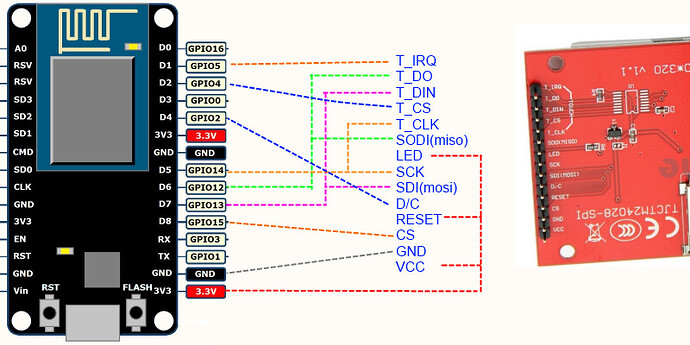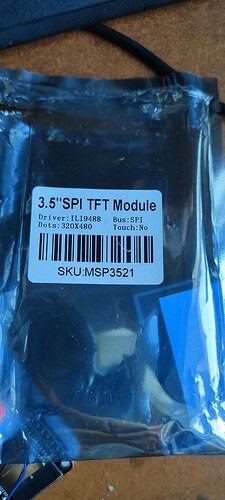снизить скорость SPI до 10 мегагерц, посмотреть осциллографом MOSI и SCK, дисплей если исправен обязан работать
фото оригинального дисплея хде ?
почитайте про перемычку j1, может поможет…
а так же мало вероятно… но возможно отключение пина gnd может поможет…(это не опечатка, у меня когда минус отключал пропадала белая пелена на дисплее, или они бракованные, или библиотеку не ту поставил… )
и вот ссылка, может это поможет))
можно попробовать перетащить на HSPI, сейчас же все пины свободны, если и там не заведётся…
https://jumpshare.com/s/hKLsBTPSBIxuf36wwOrX при определенном ракурсе вообще все белое… после такой мистики ваще пить бросишь…
#include <Adafruit_GFX.h> // Core graphics library
#include <Adafruit_ST7735.h> // Hardware-specific library for ST7735
#include <Adafruit_ST7789.h> // Hardware-specific library for ST7789
#include <SPI.h>
#if defined(ARDUINO_FEATHER_ESP32) // Feather Huzzah32
#define TFT_CS 14
#define TFT_RST 15
#define TFT_DC 32
#elif defined(ESP8266)
#define TFT_CS 4
#define TFT_RST 16
#define TFT_DC 5
#else gnd bl vcc clk dn cs rst
// For the breakout board, you can use any 2 or 3 pins.
// These pins will also work for the 1.8" TFT shield.
#define TFT_CS 10
#define TFT_RST 9 // Or set to -1 and connect to Arduino RESET pin
#define TFT_DC 8
#endif
Adafruit_ST7735 tft = Adafruit_ST7735(TFT_CS, TFT_DC, TFT_RST);
float p = 3.1415926;
void setup(void) {
Serial.begin(9600);
Serial.print(F("Hello! ST77xx TFT Test"));
tft.initR(INITR_BLACKTAB); // Init ST7735S chip, black tab
Serial.println(F("Initialized"));
uint16_t time = millis();
tft.fillScreen(ST77XX_BLACK);
time = millis() - time;
Serial.println(time, DEC);
delay(500);
// large block of text
tft.fillScreen(ST77XX_BLACK);
testdrawtext("Lorem ipsum dolor sit amet, consectetur adipiscing elit. Curabitur adipiscing ante sed nibh tincidunt feugiat. Maecenas enim massa, fringilla sed malesuada et, malesuada sit amet turpis. Sed porttitor neque ut ante pretium vitae malesuada nunc bibendum. Nullam aliquet ultrices massa eu hendrerit. Ut sed nisi lorem. In vestibulum purus a tortor imperdiet posuere. ", ST77XX_WHITE);
delay(1000);
// tft print function!
tftPrintTest();
delay(4000);
// a single pixel
tft.drawPixel(tft.width()/2, tft.height()/2, ST77XX_GREEN);
delay(500);
// line draw test
testlines(ST77XX_YELLOW);
delay(500);
// optimized lines
testfastlines(ST77XX_RED, ST77XX_BLUE);
delay(500);
testdrawrects(ST77XX_GREEN);
delay(500);
testfillrects(ST77XX_YELLOW, ST77XX_MAGENTA);
delay(500);
tft.fillScreen(ST77XX_BLACK);
testfillcircles(10, ST77XX_BLUE);
testdrawcircles(10, ST77XX_WHITE);
delay(500);
testroundrects();
delay(500);
testtriangles();
delay(500);
mediabuttons();
delay(500);
Serial.println("done");
delay(1000);
}
void loop() {
tft.invertDisplay(true);
delay(500);
tft.invertDisplay(false);
delay(500);
}
void testlines(uint16_t color) {
tft.fillScreen(ST77XX_BLACK);
for (int16_t x=0; x < tft.width(); x+=6) {
tft.drawLine(0, 0, x, tft.height()-1, color);
delay(0);
}
for (int16_t y=0; y < tft.height(); y+=6) {
tft.drawLine(0, 0, tft.width()-1, y, color);
delay(0);
}
tft.fillScreen(ST77XX_BLACK);
for (int16_t x=0; x < tft.width(); x+=6) {
tft.drawLine(tft.width()-1, 0, x, tft.height()-1, color);
delay(0);
}
for (int16_t y=0; y < tft.height(); y+=6) {
tft.drawLine(tft.width()-1, 0, 0, y, color);
delay(0);
}
tft.fillScreen(ST77XX_BLACK);
for (int16_t x=0; x < tft.width(); x+=6) {
tft.drawLine(0, tft.height()-1, x, 0, color);
delay(0);
}
for (int16_t y=0; y < tft.height(); y+=6) {
tft.drawLine(0, tft.height()-1, tft.width()-1, y, color);
delay(0);
}
tft.fillScreen(ST77XX_BLACK);
for (int16_t x=0; x < tft.width(); x+=6) {
tft.drawLine(tft.width()-1, tft.height()-1, x, 0, color);
delay(0);
}
for (int16_t y=0; y < tft.height(); y+=6) {
tft.drawLine(tft.width()-1, tft.height()-1, 0, y, color);
delay(0);
}
}
void testdrawtext(char *text, uint16_t color) {
tft.setCursor(0, 0);
tft.setTextColor(color);
tft.setTextWrap(true);
tft.print(text);
}
void testfastlines(uint16_t color1, uint16_t color2) {
tft.fillScreen(ST77XX_BLACK);
for (int16_t y=0; y < tft.height(); y+=5) {
tft.drawFastHLine(0, y, tft.width(), color1);
}
for (int16_t x=0; x < tft.width(); x+=5) {
tft.drawFastVLine(x, 0, tft.height(), color2);
}
}
void testdrawrects(uint16_t color) {
tft.fillScreen(ST77XX_BLACK);
for (int16_t x=0; x < tft.width(); x+=6) {
tft.drawRect(tft.width()/2 -x/2, tft.height()/2 -x/2 , x, x, color);
}
}
void testfillrects(uint16_t color1, uint16_t color2) {
tft.fillScreen(ST77XX_BLACK);
for (int16_t x=tft.width()-1; x > 6; x-=6) {
tft.fillRect(tft.width()/2 -x/2, tft.height()/2 -x/2 , x, x, color1);
tft.drawRect(tft.width()/2 -x/2, tft.height()/2 -x/2 , x, x, color2);
}
}
void testfillcircles(uint8_t radius, uint16_t color) {
for (int16_t x=radius; x < tft.width(); x+=radius*2) {
for (int16_t y=radius; y < tft.height(); y+=radius*2) {
tft.fillCircle(x, y, radius, color);
}
}
}
void testdrawcircles(uint8_t radius, uint16_t color) {
for (int16_t x=0; x < tft.width()+radius; x+=radius*2) {
for (int16_t y=0; y < tft.height()+radius; y+=radius*2) {
tft.drawCircle(x, y, radius, color);
}
}
}
void testtriangles() {
tft.fillScreen(ST77XX_BLACK);
uint16_t color = 0xF800;
int t;
int w = tft.width()/2;
int x = tft.height()-1;
int y = 0;
int z = tft.width();
for(t = 0 ; t <= 15; t++) {
tft.drawTriangle(w, y, y, x, z, x, color);
x-=4;
y+=4;
z-=4;
color+=100;
}
}
void testroundrects() {
tft.fillScreen(ST77XX_BLACK);
uint16_t color = 100;
int i;
int t;
for(t = 0 ; t <= 4; t+=1) {
int x = 0;
int y = 0;
int w = tft.width()-2;
int h = tft.height()-2;
for(i = 0 ; i <= 16; i+=1) {
tft.drawRoundRect(x, y, w, h, 5, color);
x+=2;
y+=3;
w-=4;
h-=6;
color+=1100;
}
color+=100;
}
}
void tftPrintTest() {
tft.setTextWrap(false);
tft.fillScreen(ST77XX_BLACK);
tft.setCursor(0, 30);
tft.setTextColor(ST77XX_RED);
tft.setTextSize(1);
tft.println("Hello World!");
tft.setTextColor(ST77XX_YELLOW);
tft.setTextSize(2);
tft.println("Hello World!");
tft.setTextColor(ST77XX_GREEN);
tft.setTextSize(3);
tft.println("Hello World!");
tft.setTextColor(ST77XX_BLUE);
tft.setTextSize(4);
tft.print(1234.567);
delay(1500);
tft.setCursor(0, 0);
tft.fillScreen(ST77XX_BLACK);
tft.setTextColor(ST77XX_WHITE);
tft.setTextSize(0);
tft.println("Hello World!");
tft.setTextSize(1);
tft.setTextColor(ST77XX_GREEN);
tft.print(p, 6);
tft.println(" Want pi?");
tft.println(" ");
tft.print(8675309, HEX); // print 8,675,309 out in HEX!
tft.println(" Print HEX!");
tft.println(" ");
tft.setTextColor(ST77XX_WHITE);
tft.println("Sketch has been");
tft.println("running for: ");
tft.setTextColor(ST77XX_MAGENTA);
tft.print(millis() / 1000);
tft.setTextColor(ST77XX_WHITE);
tft.print(" seconds.");
}
void mediabuttons() {
// play
tft.fillScreen(ST77XX_BLACK);
tft.fillRoundRect(25, 10, 78, 60, 8, ST77XX_WHITE);
tft.fillTriangle(42, 20, 42, 60, 90, 40, ST77XX_RED);
delay(500);
// pause
tft.fillRoundRect(25, 90, 78, 60, 8, ST77XX_WHITE);
tft.fillRoundRect(39, 98, 20, 45, 5, ST77XX_GREEN);
tft.fillRoundRect(69, 98, 20, 45, 5, ST77XX_GREEN);
delay(500);
// play color
tft.fillTriangle(42, 20, 42, 60, 90, 40, ST77XX_BLUE);
delay(50);
// pause color
tft.fillRoundRect(39, 98, 20, 45, 5, ST77XX_RED);
tft.fillRoundRect(69, 98, 20, 45, 5, ST77XX_RED);
// play color
tft.fillTriangle(42, 20, 42, 60, 90, 40, ST77XX_GREEN);
}
Фото дисплея в начале темы)
Перевесил, сейчас подключено так:
#define TFT_CS 15
#define TFT_MOSI 13
#define TFT_MISO 12
#define TFT_SCLK 14
#define TFT_DC 4
#define TFT_RST 2
Дисплей стал вести себя так ( моргает)
добавь в User_Setup.h
#define USE_HSPI_PORT
Выполнил.`
#define USER_SETUP_INFO "User_Setup"
#define ILI9488_DRIVER
#define USE_HSPI_PORT
Тереь его колбасит так:
а это точно ili9488?
Было предположение что это на самом деле ST7789.
Попробую изменить "User Setup " под него
Правильно ли я отредактировал “User Setup”?
#define USER_SETUP_INFO "User_Setup"
#define ST7789_DRIVER // Full configuration option,
#define USE_HSPI_PORT
// #define TFT_SDA_READ // This option is for ESP32 ONLY, tested with ST7789 and GC9A01 display only
// #define TFT_RGB_ORDER TFT_RGB // Colour order Red-Green-Blue
// #define TFT_RGB_ORDER TFT_BGR // Colour order Blue-Green-Red
// For ST7789, ST7735, ILI9163 and GC9A01 ONLY, define the pixel width and height in portrait orientation
// #define TFT_WIDTH 80
// #define TFT_WIDTH 128
// #define TFT_WIDTH 172 // ST7789 172 x 320
// #define TFT_WIDTH 170 // ST7789 170 x 320
#define TFT_WIDTH 240 // ST7789 240 x 240 and 240 x 320
// #define TFT_HEIGHT 160
// #define TFT_HEIGHT 128
// #define TFT_HEIGHT 240 // ST7789 240 x 240
#define TFT_HEIGHT 320 // ST7789 240 x 320
// #define TFT_HEIGHT 240 // GC9A01 240 x 240
// For ESP32 Dev board (only tested with ILI9341 display)
// The hardware SPI can be mapped to any pins
#define TFT_MISO 12
#define TFT_MOSI 13
#define TFT_SCLK 14
#define TFT_CS 15 // Chip select control pin
#define TFT_DC 4 // Data Command control pin
#define TFT_RST 2 // Reset pin (could connect to RST pin)
//#define TFT_RST -1 // Set TFT_RST to -1 if display RESET is connected to ESP32 board RST
#define LOAD_GLCD // Font 1. Original Adafruit 8 pixel font needs ~1820 bytes in FLASH
#define LOAD_FONT2 // Font 2. Small 16 pixel high font, needs ~3534 bytes in FLASH, 96 characters
#define LOAD_FONT4 // Font 4. Medium 26 pixel high font, needs ~5848 bytes in FLASH, 96 characters
#define LOAD_FONT6 // Font 6. Large 48 pixel font, needs ~2666 bytes in FLASH, only characters 1234567890:-.apm
#define LOAD_FONT7 // Font 7. 7 segment 48 pixel font, needs ~2438 bytes in FLASH, only characters 1234567890:-.
#define LOAD_FONT8 // Font 8. Large 75 pixel font needs ~3256 bytes in FLASH, only characters 1234567890:-.
//#define LOAD_FONT8N // Font 8. Alternative to Font 8 above, slightly narrower, so 3 digits fit a 160 pixel TFT
#define LOAD_GFXFF // FreeFonts. Include access to the 48 Adafruit_GFX free fonts FF1 to FF48 and custom fonts
#define SMOOTH_FONT
#define SPI_FREQUENCY 20000000
//#define SPI_FREQUENCY 27000000
// #define SPI_FREQUENCY 40000000
// #define SPI_FREQUENCY 55000000 // STM32 SPI1 only (SPI2 maximum is 27MHz)
// #define SPI_FREQUENCY 80000000
#define SPI_READ_FREQUENCY 20000000
#define SPI_TOUCH_FREQUENCY 2500000
Могу ли я указать свои значения высоты и ширины ( у меня 320*480)?
Выбрал St7789
User setup стал:
#define USER_SETUP_INFO "User_Setup"
#define ST7789_DRIVER // Full configuration option,
#define USE_HSPI_PORT
#define TFT_SDA_READ // This option is for ESP32 ONLY, tested with ST7789 and GC9A01 display only
// #define TFT_RGB_ORDER TFT_RGB // Colour order Red-Green-Blue
// #define TFT_RGB_ORDER TFT_BGR // Colour order Blue-Green-Red
// For ST7789, ST7735, ILI9163 and GC9A01 ONLY, define the pixel width and height in portrait orientation
// #define TFT_WIDTH 80
// #define TFT_WIDTH 128
// #define TFT_WIDTH 172 // ST7789 172 x 320
// #define TFT_WIDTH 170 // ST7789 170 x 320
#define TFT_WIDTH 240 // ST7789 240 x 240 and 240 x 320
// #define TFT_HEIGHT 160
// #define TFT_HEIGHT 128
#define TFT_HEIGHT 240 // ST7789 240 x 240
//#define TFT_HEIGHT 320 // ST7789 240 x 320
// #define TFT_HEIGHT 240 // GC9A01 240 x 240
// For ESP32 Dev board (only tested with ILI9341 display)
// The hardware SPI can be mapped to any pins
#define TFT_MISO 12
#define TFT_MOSI 13
#define TFT_SCLK 14
#define TFT_CS 15 // Chip select control pin
#define TFT_DC 4 // Data Command control pin
#define TFT_RST 2 // Reset pin (could connect to RST pin)
//#define TFT_RST -1 // Set TFT_RST to -1 if display RESET is connected to ESP32 board RST
#define LOAD_GLCD // Font 1. Original Adafruit 8 pixel font needs ~1820 bytes in FLASH
#define LOAD_FONT2 // Font 2. Small 16 pixel high font, needs ~3534 bytes in FLASH, 96 characters
#define LOAD_FONT4 // Font 4. Medium 26 pixel high font, needs ~5848 bytes in FLASH, 96 characters
#define LOAD_FONT6 // Font 6. Large 48 pixel font, needs ~2666 bytes in FLASH, only characters 1234567890:-.apm
#define LOAD_FONT7 // Font 7. 7 segment 48 pixel font, needs ~2438 bytes in FLASH, only characters 1234567890:-.
#define LOAD_FONT8 // Font 8. Large 75 pixel font needs ~3256 bytes in FLASH, only characters 1234567890:-.
//#define LOAD_FONT8N // Font 8. Alternative to Font 8 above, slightly narrower, so 3 digits fit a 160 pixel TFT
#define LOAD_GFXFF // FreeFonts. Include access to the 48 Adafruit_GFX free fonts FF1 to FF48 and custom fonts
#define SMOOTH_FONT
#define SPI_FREQUENCY 20000000
//#define SPI_FREQUENCY 27000000
// #define SPI_FREQUENCY 40000000
// #define SPI_FREQUENCY 55000000 // STM32 SPI1 only (SPI2 maximum is 27MHz)
// #define SPI_FREQUENCY 80000000
#define SPI_READ_FREQUENCY 20000000
#define SPI_TOUCH_FREQUENCY 2500000
Select_User_Setup стал:
#ifndef USER_SETUP_LOADED
#include <User_Setup.h> // Default setup is root library folder
#include <User_Setups/Setup24_ST7789.h> // Setup file for DSTIKE/ESP32/ESP8266 configured for ST7789 240 x 240
//#include <User_Setups/ILI9225.h>
#endif // USER_SETUP_LOADED
// Identical looking TFT displays may have a different colour ordering in the 16-bit colour
#define TFT_BGR 0 // Colour order Blue-Green-Red
#define TFT_RGB 1 // Colour order Red-Green-Blue
// Legacy setup support, RPI_DISPLAY_TYPE replaces RPI_DRIVER
#if defined (RPI_DRIVER)
#if !defined (RPI_DISPLAY_TYPE)
#define RPI_DISPLAY_TYPE
#endif
#endif
// Legacy setup support, RPI_ILI9486_DRIVER form is deprecated
// Instead define RPI_DISPLAY_TYPE and also define driver (e.g. ILI9486_DRIVER)
#if defined (RPI_ILI9486_DRIVER)
#if !defined (ILI9486_DRIVER)
#define ILI9486_DRIVER
#endif
#if !defined (RPI_DISPLAY_TYPE)
#define RPI_DISPLAY_TYPE
#endif
#endif
// Invoke 18-bit colour for selected displays
#if !defined (RPI_DISPLAY_TYPE) && !defined (TFT_PARALLEL_8_BIT) && !defined (TFT_PARALLEL_16_BIT) && !defined (ESP32_PARALLEL)
#if defined (ILI9481_DRIVER) || defined (ILI9486_DRIVER) || defined (ILI9488_DRIVER)
#define SPI_18BIT_DRIVER
#endif
#endif
// Load the right driver definition - do not tinker here !
#if defined (ILI9341_DRIVER) || defined(ILI9341_2_DRIVER) || defined (ILI9342_DRIVER)
#include <TFT_Drivers/ILI9341_Defines.h>
#define TFT_DRIVER 0x9341
#elif defined (ST7735_DRIVER)
#include <TFT_Drivers/ST7735_Defines.h>
#define TFT_DRIVER 0x7735
#elif defined (ILI9163_DRIVER)
#include <TFT_Drivers/ILI9163_Defines.h>
#define TFT_DRIVER 0x9163
#elif defined (S6D02A1_DRIVER)
#include <TFT_Drivers/S6D02A1_Defines.h>
#define TFT_DRIVER 0x6D02
#elif defined (ST7796_DRIVER)
#include "TFT_Drivers/ST7796_Defines.h"
#define TFT_DRIVER 0x7796
#elif defined (ILI9486_DRIVER)
#include <TFT_Drivers/ILI9486_Defines.h>
#define TFT_DRIVER 0x9486
#elif defined (ILI9481_DRIVER)
#include <TFT_Drivers/ILI9481_Defines.h>
#define TFT_DRIVER 0x9481
#elif defined (ILI9488_DRIVER)
#include <TFT_Drivers/ILI9488_Defines.h>
#define TFT_DRIVER 0x9488
#elif defined (HX8357D_DRIVER)
#include "TFT_Drivers/HX8357D_Defines.h"
#define TFT_DRIVER 0x8357
#elif defined (EPD_DRIVER)
#include "TFT_Drivers/EPD_Defines.h"
#define TFT_DRIVER 0xE9D
#elif defined (ST7789_DRIVER)
#include "TFT_Drivers/ST7789_Defines.h"
#define TFT_DRIVER 0x7789
#elif defined (R61581_DRIVER)
#include "TFT_Drivers/R61581_Defines.h"
#define TFT_DRIVER 0x6158
#elif defined (ST7789_2_DRIVER)
#include "TFT_Drivers/ST7789_2_Defines.h"
#define TFT_DRIVER 0x778B
#elif defined (RM68140_DRIVER)
#include "TFT_Drivers/RM68140_Defines.h"
#define TFT_DRIVER 0x6814
#elif defined (SSD1351_DRIVER)
#include "TFT_Drivers/SSD1351_Defines.h"
#define TFT_DRIVER 0x1351
#elif defined (SSD1963_480_DRIVER)
#include "TFT_Drivers/SSD1963_Defines.h"
#define TFT_DRIVER 0x1963
#elif defined (SSD1963_800_DRIVER)
#include "TFT_Drivers/SSD1963_Defines.h"
#define TFT_DRIVER 0x1963
#elif defined (SSD1963_800ALT_DRIVER)
#include "TFT_Drivers/SSD1963_Defines.h"
#define TFT_DRIVER 0x1963
#elif defined (SSD1963_800BD_DRIVER)
#include "TFT_Drivers/SSD1963_Defines.h"
#define TFT_DRIVER 0x1963
#elif defined (GC9A01_DRIVER)
#include "TFT_Drivers/GC9A01_Defines.h"
#define TFT_DRIVER 0x9A01
#elif defined (ILI9225_DRIVER)
#include "TFT_Drivers/ILI9225_Defines.h"
#define TFT_DRIVER 0x9225
#elif defined (RM68120_DRIVER)
#include "TFT_Drivers/RM68120_Defines.h"
#define TFT_DRIVER 0x6812
#elif defined (HX8357B_DRIVER)
#include "TFT_Drivers/HX8357B_Defines.h"
#define TFT_DRIVER 0x835B
#elif defined (HX8357C_DRIVER)
#include "TFT_Drivers/HX8357C_Defines.h"
#define TFT_DRIVER 0x835C
// <<<<<<<<<<<<<<<<<<<<<<<< ADD NEW DRIVER HERE
// XYZZY_init.h and XYZZY_rotation.h must also be added in TFT_eSPI.cpp
#elif defined (XYZZY_DRIVER)
#include "TFT_Drivers/XYZZY_Defines.h"
#define TFT_DRIVER 0x0000
#else
#define TFT_DRIVER 0x0000
#endif
// These are the pins for ESP8266 boards
// Name GPIO NodeMCU Function
#define PIN_D0 16 // GPIO16 WAKE
#define PIN_D1 5 // GPIO5 User purpose
#define PIN_D2 4 // GPIO4 User purpose
#define PIN_D3 0 // GPIO0 Low on boot means enter FLASH mode
#define PIN_D4 2 // GPIO2 TXD1 (must be high on boot to go to UART0 FLASH mode)
#define PIN_D5 14 // GPIO14 HSCLK
#define PIN_D6 12 // GPIO12 HMISO
#define PIN_D7 13 // GPIO13 HMOSI RXD2
#define PIN_D8 15 // GPIO15 HCS TXD0 (must be low on boot to enter UART0 FLASH mode)
#define PIN_D9 3 // RXD0
#define PIN_D10 1 // TXD0
#define PIN_MOSI 8 // SD1 FLASH and overlap mode
#define PIN_MISO 7 // SD0
#define PIN_SCLK 6 // CLK
#define PIN_HWCS 0 // D3
#define PIN_D11 9 // SD2
#define PIN_D12 10 // SD4
Setup24_ST7789 стал:
// ST7789 240 x 240 display with no chip select line
#define USER_SETUP_ID 24
#define ST7789_DRIVER // Configure all registers
#define TFT_WIDTH 240
#define TFT_HEIGHT 240
#define TFT_RGB_ORDER TFT_RGB // Colour order Red-Green-Blue
//#define TFT_RGB_ORDER TFT_BGR // Colour order Blue-Green-Red
//#define TFT_INVERSION_ON
//#define TFT_INVERSION_OFF
// DSTIKE stepup
//#define TFT_DC 23
//#define TFT_RST 32
//#define TFT_MOSI 26
//#define TFT_SCLK 27
Generic ESP32 setup
#define TFT_MISO 12
#define TFT_MOSI 13
#define TFT_SCLK 14
#define TFT_CS -1 // Not connected
#define TFT_DC 4
#define TFT_RST 2 // Connect reset to ensure display initialises
// For NodeMCU - use pin numbers in the form PIN_Dx where Dx is the NodeMCU pin designation
#define TFT_CS -1 // Define as not used
#define TFT_DC PIN_D4 // Data Command control pin
#define TFT_RST PIN_D2 // TFT reset pin (could connect to NodeMCU RST, see next line)
//#define TFT_RST -1 // TFT reset pin connect to NodeMCU RST, must also then add 10K pull down to TFT SCK
#define LOAD_GLCD // Font 1. Original Adafruit 8 pixel font needs ~1820 bytes in FLASH
#define LOAD_FONT2 // Font 2. Small 16 pixel high font, needs ~3534 bytes in FLASH, 96 characters
#define LOAD_FONT4 // Font 4. Medium 26 pixel high font, needs ~5848 bytes in FLASH, 96 characters
#define LOAD_FONT6 // Font 6. Large 48 pixel font, needs ~2666 bytes in FLASH, only characters 1234567890:-.apm
#define LOAD_FONT7 // Font 7. 7 segment 48 pixel font, needs ~2438 bytes in FLASH, only characters 1234567890:.
#define LOAD_FONT8 // Font 8. Large 75 pixel font needs ~3256 bytes in FLASH, only characters 1234567890:-.
//#define LOAD_FONT8N // Font 8. Alternative to Font 8 above, slightly narrower, so 3 digits fit a 160 pixel TFT
#define LOAD_GFXFF // FreeFonts. Include access to the 48 Adafruit_GFX free fonts FF1 to FF48 and custom fonts
#define SMOOTH_FONT
// #define SPI_FREQUENCY 27000000
#define SPI_FREQUENCY 40000000
#define SPI_READ_FREQUENCY 20000000
#define SPI_TOUCH_FREQUENCY 2500000
// #define SUPPORT_TRANSACTIONS
Результат - так же моргает
попробуй этот, замаркированные это все дисплеи 3.5"
вносить изменения тебе можно только в одном файле - User_Setup.h
#define ST7796_DRIVER // Generic driver for common displays
//#define ST7789_DRIVER // Full configuration option, define additional parameters below for this display
//#define ST7789_2_DRIVER // Minimal configuration option, define additional parameters below for this display
//#define ST7365_DRIVER
//#define GC9A01_DRIVER
//#define GC9B71_DRIVER
//#define GC9307_DRIVER
#define TFT_WIDTH 320
#define TFT_HEIGHT 480
40 мегагерц может для твоего дисплея много, поставь 20
Так как похоже что в библиотеке TFT_eSPI ты уже основательно поковырялся, снеси и установи заново, твой файл для установок ТОЛЬКО User_Setup.h
Хорошо, снёс её совсем, внёс изменения только в указанный файл.Экран-белый.
как вариант попробовать на софтовом SPI


